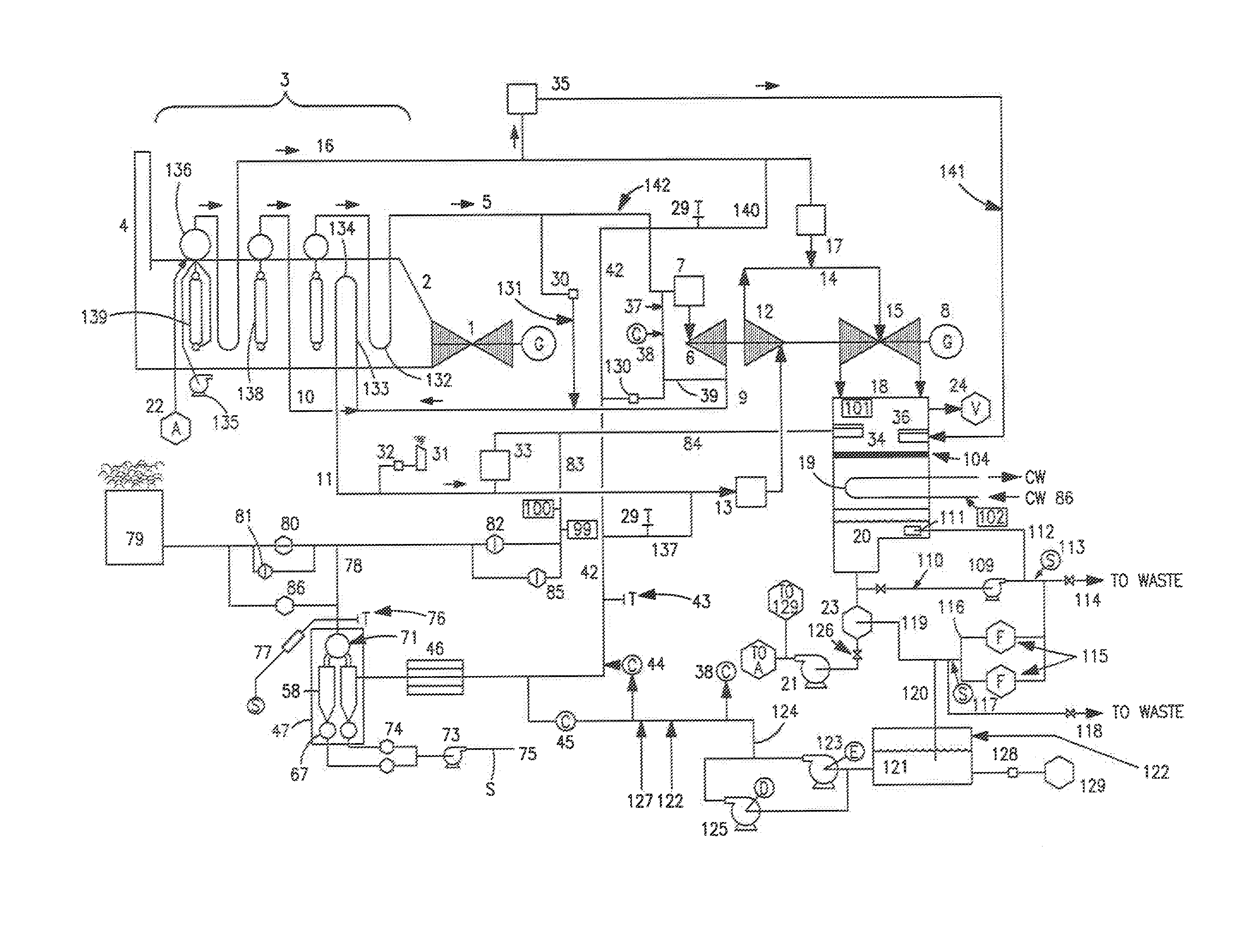Particulate debris may also plug or damage the internal surfaces of steam valves used to control the flow of steam.
The presence of anions in the steam will lead to the potential of stress
cracking of
steam turbine components.
Chlorides, organic anions and sulfates in the steam
pose a particular danger for the onset of stress
cracking.
The presence of
sodium in the steam risks the deposition of alkalis and / or other salts.
While all of the above prior art methods may be successful in the removal of
particulate contamination from the steam generator and
pipe delivering steam to the steam
turbine, the above prior art methods do not integrate the cleaning practices into other commissioning activities of the
plant.
Little if any effort is made to remove particulate and other
contamination found in the condenser.
The
chemical cleaning processes also generate large volumes of waste solution and waste flush water.
Prior art methods make little effort to optimize conditions that will increase the rate of silica, elements that contribute to cation
conductivity and other salt contaminants.
The operation of a plant in steam bypass mode to the condenser is not optimized for the removal of silica and other contaminating salts in the steam.
Cooling of the bypass steam will result in the
precipitation of silica dissolved in the steam.
Corrosion following
chemical cleaning, hydro-milling or other forms of mechanical cleaning may result in the formation of new particulate and salt contamination in the systems previously cleaned.
Use of
corrosion inhibitors or other agents to preserve the cleaned surfaces may only exacerbate to amount of salts and organic compounds that will contaminate the steam during initial operation of the steam generator in bypass mode to the condenser.
The prior art practices of “discontinuous
high pressure steamblow” and the “low pressure continuous steamblow” exhaust all steam from the steam cycle during the cleaning process, these methods require large volumes of high quality water, may take weeks to complete, and can result in environmental issues such as
noise, related to the
discharge of large volumes of steam.
In addition, these methods do not generate conditions highly favorable to the removal of silica, elements that result in elevated cation
conductivity or other non-particulate steam contamination.
These methods also do not involve the condenser and therefore do nothing to address contamination that might originate from the extensive amount of contaminated
metal surface area in the condenser.
These practices also require operation of the steam generator for an extended period of time with little possibility for other normal commissioning activities to be performed.
The fuel consumed during such steamblow operations represents a significant expense.
Extended operation of
gas turbines of
combined cycle power plants before tuning of the burners to minimize emissions during prior art methods also results in significant exhaust emissions.
In addition to the above, the prior art practices make only limited provisions for the assured protection of the condenser during the
discharge of steam to the condenser.
Specifically, none of the prior art practices make adequate provisions to prevent the continued discharge of steam to the condenser should the condenser lose
coolant flow or should attemperation water used to cool the steam being discharged to the condenser be interrupted.
Prior art practices that rely on operation of the
steam system in bypass mode through the
bypass valve do not provide an assured means of protecting plant bypass valves from contamination or conditions that may cause the
bypass valve to not close fully when plant conditions would require such closure to protect the condenser from damage.
These same prior art methods make no provision to insure that the conditions generated by operation of the
steam generation system in the bypass mode will optimize conditions for removal of either
solid particle or other types of steam contamination due to the
high pressure drop normally associated with typical bypass valves and the high
back pressure of typical steam distribution sparge tubes in the condensers.
Although some prior art provides for the installation of sacrificial tubes in the top layer of the condenser tube
bank, none of the prior art
cleaning methods provide for an assured means of shielding condenser tubes from
high velocity particles or
moisture droplets discharged into the condenser at high velocities.
Most prior art
steam system cleaning methods do not provide for the comprehensive treatment of the steam condensate generated in the condenser during bypass mode operation.
As a result, particulate contamination found in this condensate will result in the plugging of condensate and
boiler feedwater pump strainers.
Use of
ion exchange beds to remove salt ions is expensive and is rarely applied.
Further, the prior art methods do not provide a means of cleaning the steam exhausted from the steam generator and steam piping to remove contamination prior to the admission of the steam to the condenser.
Contamination transported by the initial steam discharged to the condenser will foul the condenser and may result in mechanical damage to the condenser due to the
high velocity impingement of particulate contamination and entrained condensate droplets on the
thin wall condenser tubing.
Although some prior art methods provide for the installation of a
metal target plate into the bypass steam circuit to the condenser to monitor the presence of particulate contamination, none of the prior art methods make provision for the diversion of contaminated steam away from the condenser when particulate contamination is indicated by such targets.
In addition, prior art methods have not been practiced to generate physical and chemical conditions in the steam path that will insure the formation of a passive
coating on the metal surfaces consistent with that formed by long term operation of the steam
system at normal operating conditions.
 Login to View More
Login to View More  Login to View More
Login to View More 


